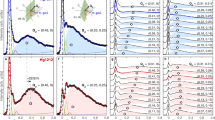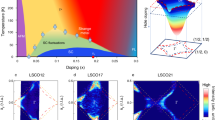Abstract
Arising from: G.-H. Gweon et al. Nature 430, 187–190 (2004)
The possibility that a pairing boson might act as the 'glue' to bind electrons into a Cooper pair in superconductors with a high critical temperature (Tc) is being actively pursued in condensed-matter physics. Gweon et al.1 claim that there is a large and unusual oxygen-isotope effect on the electronic structure, indicating that phonons have a special importance in high-temperature superconductors. However, we are unable to detect this unusual oxygen-isotope effect in new data collected under almost identical material and experimental conditions. Our findings point towards a more conventional influence of phonons in these materials.
Similar content being viewed by others
Main
In the high-temperature superconductors, oxygen-isotope exchange has been found to have a very small effect on the Tc, particularly for optimally doped (highest-Tc) samples2. It was therefore unexpected when Gweon et al. reported a large isotope effect on the electronic structure in optimally doped Bi2Sr2CaCu2O8+δ using angle-resolved photoemission spectroscopy (ARPES)1. This isotope effect was seen mainly at a broad, high-energy hump feature and was unusually large (10–40 meV shift), by contrast with the expected isotopic phonon shifts of the order of 3 meV. It was argued by many that this is experimental evidence that the coupling between the lattice and electrons plays a particularly significant role.
Figure 1a shows our energy–momentum (E–k) dispersion relations for both 16O and 18O taken along the 'nodal' direction of the Brillouin zone. The results show an insignificant shift for the deeper states of −0.9 ± 0.4 meV, by contrast with Fig. 1b of Gweon et al.1, which shows a 15-meV shift of more deeply lying states. We found that precise rotational alignment of the samples was crucial to obtain repeatable energy positions, especially in the high-energy regime discussed here. The negligible energy shift was confirmed by using three different facilities, samples with multiple doping levels, including the optimal doping described in ref. 1, and with various photon energies, including the same energy used by Gweon et al.1 (33 eV), and a low photon energy (7.0 eV) that gives extreme resolution, as well as increased bulk sensitivity.
All data are from optimally doped (Tc = 92 K, unexchanged) Bi2Sr2CaCu2O8+δ crystals taken with 33 eV photons at 15 K. Blue line and symbols, 16O data; red line and symbols, 18O data. No large-scale shift of the spectra with isotope exchange is evident. a, Nodal dispersion (red diagonal line in b, inset) obtained by fitting momentum-distribution curves, in which kF is the Fermi momentum. b (left), Energy-distribution curve from each isotope at the k-point indicated (arrowhead); right, dispersion of the band bottom from energy-distribution peaks along the (0,−π)−(0, π) symmetry line (horizontal lines in the Fermi surface inset).
Gweon et al.1 show an even larger effect (up to 40 meV) at the 'antinodal' portions of the Brillouin zone (towards the (0,π) and (0,−π) points) — comparable data are shown here in Fig. 1b. We studied ten cuts that had a similar geometry to the key cut 7 of Gweon et al.1, with half of the cuts at positive ky (momentum along the y direction) values and the others at negative ky. Having data on both sides of the (0,0) point allowed the correction of any very slight (0.1 degrees) sample misalignments, which is crucial for removing systematic alignment errors that could cause apparent energy shifts. Figure 1b (right) shows the dispersion of the bottom of the band (determined in each cut as in Fig. 2d of Gweon et al.1) along the (0,−π)→(0,π) symmetry line. The ten sets in Fig. 1b have an average isotope shift of the band bottom of 2 ± 3 meV, which is inconsistent with the 10–40 meV level found by Gweon et al.1.
Our result is not inconsistent with the tunnelling result of a conventional phononic isotope shift on the scale of about 3 meV (refs 3,4) that was performed on the same samples and which conceivably could be seen near the kink energy in future ultra-resolution ARPES.
Although we do not observe the unusual large-scale isotope effect reported by Gweon et al.1, our result does not invalidate electron–phonon coupling as a potential pairing mechanism for high-temperature superconductivity. Rather, it implies that if electron–phonon coupling is responsible, it must do it in a more subtle, roundabout way.
Methods. Our data were measured with 33-eV photons at BL12 of the Advanced Light Source, Berkeley, USA, by use of a high-precision 6-axis sample manipulator. Single crystals of Bi1.9Sr2.1CaCu2O8+δ were annealed in either 18O2 or 16O2 gas under the same thermal conditions: 800 °C at 1 atmosphere for 168 h, followed by 700 °C at 0.2 bar for 24 h. The Tc values of the samples decreased from 92 K to 91 K on isotope substitution. Raman spectra showed a clear shift of the B1g vibration modes, confirming that isotope substitution was nearly complete at 80% or more.
References
Gweon, G.-H. et al. Nature 430, 187–190 (2004).
Franck, J. P. in Physical Properties of High Temperature Superconductors IV (ed. Ginsberg, D. M.) 189–293 (World Scientific, Singapore, 1994).
Lee, J. et al. Nature 442, 546–550 (2006).
de Lozanne, A. Nature 442, 522–523 (2006).
Author information
Authors and Affiliations
Corresponding author
Ethics declarations
Competing interests
The authors declare no competing financial interests.
Rights and permissions
About this article
Cite this article
Douglas, J., Iwasawa, H., Sun, Z. et al. Unusual oxygen isotope effects in cuprates?. Nature 446, E5 (2007). https://doi.org/10.1038/nature05738
Received:
Accepted:
Published:
Issue Date:
DOI: https://doi.org/10.1038/nature05738
Comments
By submitting a comment you agree to abide by our Terms and Community Guidelines. If you find something abusive or that does not comply with our terms or guidelines please flag it as inappropriate.




